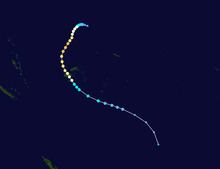Damage $20 million (1972 USD) Fatalities 24 | ||
 | ||
Formed October 19, 1972 (1972-10-19) Dissipated October 28, 1972 (1972-10-28) Highest winds 10-minute sustained: 155 km/h (100 mph)1-minute sustained: 205 km/h (125 mph) Lowest pressure 945 hPa (mbar); 27.91 inHg Date 19 October 1972 – 28 October 1972 Similar Cyclone Keli, Cyclone Ofa, Cyclone Tia, Cyclone Kina, Cyclone Hina | ||
Severe Tropical Cyclone Bebe, also known as Hurricane Bebe, was a pre-season storm in the South Pacific Ocean that impacted Fiji, the Ellice Islands (now Tuvalu) and the Gilbert Islands (now Kiribati) during October 1972.
Contents
Meteorological history
During October 16, 1972, two tropical disturbances developed, on both sides of the equator near the 175th meridian west. The first tropical disturbance developed in the Northern Hemisphere and eventually developed into Typhoon Olga during October 25, where it directly impacted the Marshall Islands. The second disturbance developed within the Southern Pacific Ocean, where it started to move westwards and show signs of developing into a tropical cyclone during October 19. As the disturbance intensified further; it became equivalent to a modern-day category 1 tropical cyclone on the Australian Tropical Cyclone Intensity Scale during October 20. The newly named system subsequently continued to intensify and was classified as a hurricane during October 21, before it passed near or over Funafuti atoll, where hurricane force winds were recorded.
During October 22, Bebe weakened slightly, as it passed about 120 km (75 mi) to the west of the Tuvaluan reef island Niulakita. By this time the systems circulation extended out about 965 km (600 mi) and had started to move south-eastwards. Bebe was subsequently located about 60 km (35 mi) to the northeast of Rotuma, by a Royal New Zealand Air Force aircraft that was on a search and rescue mission to Tuvalu. The system subsequently passed near too or over Rotuma and peaked with 10-minute sustained winds estimated at 155 km/h (100 mph) and 1-minute sustained wind speeds of 205 km/h (125 mph) which made it equivalent to a category 3 tropical cyclone on both the Australian Scale and Saffir-Simpson hurricane wind scale. After affecting Rotuma with hurricane force winds during that day, the system moved southwards towards the main islands of Fiji, and appeared on the Cossor Radar screen at the Nadi Meteorological Office during October 23. The centre of the hurricane moved on to the north coast of Viti Levu.
During October 25, Bebe transitioned into an extra-tropical cyclone, before its remnants were last noted on October 28.
Impact
Bebe impacted both modern day Tuvalu and the Fijian islands where it left 28 people dead and thousands homeless. Overall damages were estimated at over $20 million (1972 USD).
Tuvalu
Modern day Tuvalu was the first island nation to be impacted by Bebe between October 19–22, while it was a British colony and known as the Ellice Islands. The system started to impact Tuvalu during October 19, with intermittent heavy rain reported in the island nation, before the weather deteriorated further during the next day, with strong winds increasing to gale force, flooding and a rough sea reported. During October 20, as the seas were rough, the ship Moana Raoi that had just arrived in Funafuti's lagoon carrying supplies from Suva, Fiji was anchored peacefully. During the next day, as the Funafuti International Airport airstrip was flooded, the fortnightly Air Pacific aircraft that was carrying supplies from Nadi, Fiji, turned back while it was located about 80 km (50 mi) from the airstrip. After a hurricane warning was received at the New Zealand Meteorological Service weather station, its chief tried to warn as many people as possible, including the Master of the Moana Raoi, the fishery officer of the Van Camp fishing fleet and the agent of the Gilbert and Ellice Islands development authority.
There was subsequently little to no significant damage recorded on the majority of the islands, however, the low lying island of Funafuti was significantly impacted after the system passed over the coral atoll during October 21. Hurricane force winds were observed on the island for several hours, while a storm surge swept over the island and killed three people.
Fiji
Bebe impacted the whole of the newly independent island nation of Fiji between October 22–25, where it became the worst tropical cyclone to impact the islands since 1952. Ahead of the system threatening the Fijian Islands, the Nadi weather office issued hurricane warnings, for most of the island nation including Rotuma. As a result, hurricane shutters were put up on various buildings, schools were closed, local air service and cruise ships were cancelled while other smaller ships took shelter. The Nadi and Nausori international airports were also closed. On October 22, the Fijian Parliament was adjourned in order to prepare for the hurricane.
During October 23, the system passed over the Fijian Dependency of Rotuma, with hurricane force wind speeds of around 275 km/h (170 mph) had been recorded on the island. As a result widespread damage was reported on the island, with various houses and other buildings either destroyed or extensively damaged. The island also lost the majority of its crops, with coconut palms, copra and citrus trees damaged or destroyed. As a result it was estimated that between 60%-90% of the population would be dependent, on relief supplies for three-six months.
